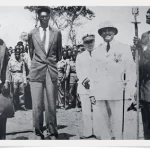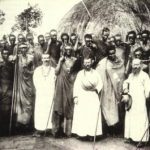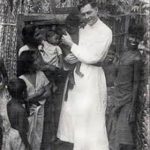Christian Influence
With the arrival of the Europeans, Christianity spread rapidly in Rwanda. We will not be concerned here with the impact of Christianity in terms of the introduction of egalitarian and individualistic ideas.
The catholic missionaries were the first to arrive in Rwanda in 1900. The king allowed them to open their missionsstations. From the earliest missionary reports we have detailed evidence of the very close co-operation which existed between the missionaries and the german authorities. In 1915permission was granted by the king to open a mission in Central Rwanda. Figures from the reports show that from the start Christianity spread far less rapidly in the North and East than in the Centre. This might well be related to the evident alliance between the missionaries and the colonial powers who were very much occupied in trying to establish and maintain central government authority in these areas against strong and often violent opposition. The following notes from the reports illustrate this point. When in 1904the people rebelled against the newly established authorities and put them to flight, the German troops intervened:
“Les gens voient leur huttes flambées, leur bananeraies coupées, leur vaches prendre le chemin de Rwanda central. Quelques morts completent le châtiment. La punition nous la regrettons guère, car les gens sont vraiment peu sociables. C’etait un châtiment uniquement pour venger l’autoritéméconnue des chefs Tutsi ……..venus de la capitale »(Nyundo 1904)
From the same mission we read in 1912; « Nous refusons de soigner les blessures pour faire perdre à nos gens l’envoie de se battre ».
When in 1907 the first protestant missionaries arrived fromGermany there were already 2,822 baptised catholics, most ofthem Hutu. Shortly afterwards however, when the Baganda catechists returned to Uganda, they were replaced by Hutu and several Hutu Christians were given paid jobs by the Europeans. At this point the Tutsi began to see that their adverse attitude to Christianity was doing them harm. They started to join in large numbers and everywhere special catechumenates were arranged for them. In the reports of 1906 we read still that Christians were recruited principally from the Hutu stratum of the population. But in 1925,« Les jeunes gens Tutsi demandent leur admissionen grand nombre. Ils ont des qualitées qui en font vraiment une race supérieure1 ».In 1928 a full cousin of the king was baptised and in I929″Il ne reste guère des Batutsi importants paiens”. The number of catholics increased from 4 1 , 0 0 0 in 1 9 2 9 to 2 8 9 ,0 0 0in 1 9 5 9 to 1 ,1 0 0 , 0 0 0 in 1 9 6 2 , or 3 7. 5 per cent of the total population. In 1962 7.5 per cent of the population wasprotestant. There was a very notable increase in 1949 whenthe government decided that all catechumens should be exempt from “corvée”, on the days they received religious instruction.
Concomitant with this measure we see that during the following years the number of catechumens, largely Hutu, more than doubled from less than 1 0 0 , 0 0 0 to more than 2 0 0 ,0 0 0 annually. The protestant mission developed much more slowly, not only because of a much later start but also because, when in 1916Rwanda was occupied by Belgian troops, the german protestant missionaries left and were only replaced in 19 19by a very small number of Belgian protestant missionaries, later helped by the Danish mission and the C.M.S. While nearly all the catholic missionaries were Belgian, the protestant missionaries were largely non-Belgian. Thiswas of no small importance in relation to the subsidies given to schools, which were, up till 1 9 4 8, reserved to.
In 1958 about 160,000 children were receiving primaryschool education all of which, except one, were run by themissions. Primary education was divided into two kinds;first degree, which consisted of a two year course attended by 105,000 children. About half of these went to primary school second degree for another two years, after which selection was again made and 4,000 or 2.5 per cent of those who had started primary school went to a fifth and last
year of primary school education. From this last group were selected those who went on to post primary education, for this there were three possibilities.
In 1958 all three secondary schools were run by catholics.Two of these had been started in 1955. Up till then there was only one secondary school with 305students. This school was called Groupe seolaire d’Astrida and had two sections; (a) a secondary school with 213 students and (b) a superior section for training of medical, veterinary and agricultural assistants and a school for chiefs. This last school had been started in 1929 to prepare sons of chiefs for their future task, which was not necessarily the same as the one held by their fathers. This superior section had in all 88 students. In 1958 the secondary schools had together 599 boys and 70 girls as students. Thirty per cent of these students were Hutu. Of the students of the superior section at the Groupe scolaire d ‘Astrida only 5 per cent were Hutu.
Up till 1950 there was one teacher training school run by the catholics. In 1958 there were five teacher training schools for boys and three for girls managed by the catholic mission. Apart from these there was a mixed teacher training school managed by the protestant mission and another run by the government. However no details are available as to the relative numbers of Tutsi and Hutu among the students. The first technical school was started in Kigali in 1957 although for some time several missions had trained carpenters, masons and tailors.
The missionary reports often mention the fact that government officials and other europeans in private enterprise asked the mission for suitable personnel and thus the mission became the most important stepping stone for material advancement. This close co-operation was well expressed by Mgr. Classe the catholic bishop in Rwanda, in 1933. In his appreciation of the Mwami, who had become a catholic himself.« Mutara prend son role au sérieux. II a desqualités de chef chrétien. II prend souvent conseil à lamission et plus encore chez moi. »
The number of primary schools allowed about 30 per cent of the catholic children access to primary education. However most of the places were given to Tutsi children. This was related to the fact that the Tutsi children were thought of as belonging to a “race supérieure”, and that the children of the rich were less needed at home to help in cultivation. As we have seen, places in the school for chiefs, leading to a position as chief or subchief, were solely for the sons of chiefs, meaning important Tutsi. In 1959 all chiefs and 98 per cent of all the subchiefs were Tutsi (Hubert I965 p.13).
From the foregoing some conclusions seem justified in relation to the spread of Christianity in Rwanda:
1.widespread adoption of Christianity, especially of Catholicism.
2. Close co-operation between government and church, both favouring catholic Tutsi.
3. Infiltration of Christianity greater in the centre than in the peripheral areas.
4. Massive conversions of the Hutu only after 1950 and government intervention.
5.Political power nearly exclusively in the hands of catholic Tutsi.
6. Education, especially at the post primary school level largely limited to Tutsi. Post secondary educationnearly exclusively reserved for Tutsi.
https://uk.amateka.net/christian-influence/https://uk.amateka.net/wp-content/uploads/2019/11/apostolat.jpghttps://uk.amateka.net/wp-content/uploads/2019/11/apostolat-150x150.jpgMissionary historyWith the arrival of the Europeans, Christianity spread rapidly in Rwanda. We will not be concerned here with the impact of Christianity in terms of the introduction of egalitarian and individualistic ideas. The catholic missionaries were the first to arrive in Rwanda in 1900. The king allowed them to open their missionsstations. From the...BarataBarata rpierre@ikaze.netAdministratorAMATEKA | HISTORY OF RWANDA



